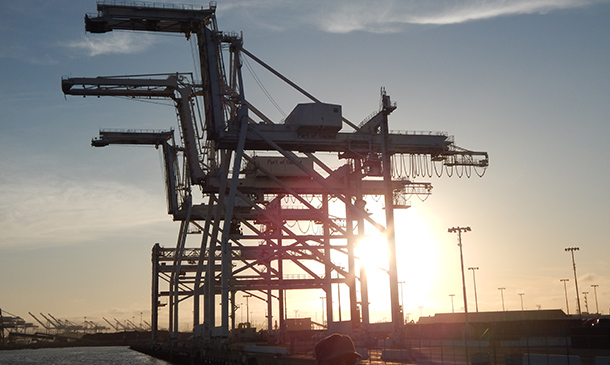
Port of Oakland (Photo Credit: Mike Linksvayer/Flickr)
Megan Joseph is a policy and community development professional and executive director of Rise Together Bay Area — a group leading a regional approach to end poverty. She shares more information about her organization and regionalization as an effective approach to dealing with upward mobility in California.
California is teeming with life, opportunity and diversity. We are touted as the hotbed of innovation and forward thinking. And yet families in California are facing higher poverty rates, higher cost of living, higher housing cost burden and greater disparities than almost anywhere in the country. Why is it that in a state with so much promise, one in four families are simply trying to eek out an existence?
As the executive director of Rise Together Bay Area, a nine-county regional approach to end poverty, this question is at the forefront of my mind on any given day, and the answer is increasingly complex. I’m pleased that the California Economic Summit is promoting this conversation for what we all agree is a fundamental issue of the day for the future of California.
For our purposes, Rise Together has distilled it to several key ingredients:
For one, opportunity is unevenly distributed and these disparities are growing daily. When we mapped opportunity across the Bay Area for our 2015 Family Economic Security Report with the Insight Center for Community Economic Development and the HAAS Institute for a Fair and Inclusive Society, there were clear and visible disparities among and between the Bay Area region’s counties, cities, and neighborhoods. For example, some cities in the region, such as Berkeley, Fremont, San Francisco and San Mateo, have “high” opportunity in a majority of their census tracts, yet places such as Hayward, Oakland, Richmond and Vallejo have greater concentrations of “low” opportunity census tracts.
Add to this that the cost of living in California has left low-wage working families behind. A family of four in the Bay Area needs to make $76,543 to cover their basic expenses, according to the Self-Sufficiency Standard. Compare this to two full-time minimum wage jobs at $10/hour equaling a mere $41,600. For many individuals struggling to make ends meet, finding one full-time minimum wage job is nearly impossible because of the numerous barriers to entering the workforce such as: lack of work experience, conviction of a crime, inequitable access to training and educational opportunities, discriminatory hiring practices, unstable housing or lack of transportation.
We then add the fact that 40 percent of Bay Area residents pay more than one-third of their income on housing. California real estate prices have risen three times faster than household incomes. 48 percent of Bay Area neighborhoods are experiencing displacement, forcing households to move to areas where opportunities and resources are thinner, and low-income communities of color are more likely to be displaced and impacted by the housing crisis.
The urgency to solve the great crisis of disparity is elevated and we must consider this question from a different level of thinking than has come before. There is a growing awareness that these and other pressing issues facing our economy, transportation, labor market, housing market and other essential components of a thriving community are growing in complexity and cross local boundaries and traditional sectors.
As the Executive Director of Urban Strategies Council and Rise Together Steering Council member David Harris put it, “…these issues are significantly interdependent within and across streams. For example, economic competitiveness is simultaneously a problem of environmental sustainability, social equity, and effective governance.”
Enter a critical yet often missing component of meeting these challenges – a vehicle for a coordinated and inclusive regional approach that helps lift up and scale what works, address policies and systems that are no longer working, activate learning across boundaries, level the playing field across geographies and innovate across traditional sector lines.
It was out of this thinking that Rise Together Bay Area was born, with a mission to unite the nine-county Bay Area to advance access to opportunities for self-sufficiency. We work toward this mission through a regional coalition of over 200 organizations to accelerate systems and policy change in employment, education, housing and basic needs.
Through our four pillars – Leadership Development & Partnership Building, Policy Advocacy, Strategic Communications and Data for Informed Decision Making – we help inform, connect and align organizations across the region working on the key drivers of poverty to accelerate systems and policy change.
 When every Californian has access to opportunity and self-sufficiency, we all win. If we do not stem the tide of disparity and lack of opportunity among millions of Californians, however, we will all lose. Resistance to change in the name of territorial battles, narrow interests or fiscal disincentive will no longer suffice. We cannot fulfill the promise and potential of California if we do not break down the siloes of sector and geographic boundary, invisible lines that our economies and communities have long since crossed. The time of regionalization has come and its power is unstoppable. We hope you will join us.
When every Californian has access to opportunity and self-sufficiency, we all win. If we do not stem the tide of disparity and lack of opportunity among millions of Californians, however, we will all lose. Resistance to change in the name of territorial battles, narrow interests or fiscal disincentive will no longer suffice. We cannot fulfill the promise and potential of California if we do not break down the siloes of sector and geographic boundary, invisible lines that our economies and communities have long since crossed. The time of regionalization has come and its power is unstoppable. We hope you will join us.
Elevate CA addresses the reasons for and solutions to the vexing issue of economic insecurity that plagues the California economy and jeopardizes our future. These conversations will culminate at the California Economic Summit in San Diego on November 2-3 where policy recommendations will be discussed and formulated.

